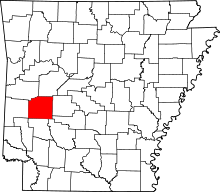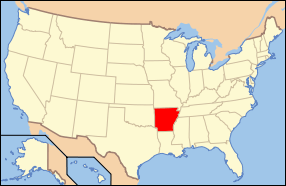Montgomery County, Arkansas
| Montgomery County, Arkansas | |
|---|---|
 Montgomery County Courthouse in Mount Ida | |
 Location in the U.S. state of Arkansas | |
 Arkansas's location in the U.S. | |
| Founded | December 9, 1842 |
| Named for | Richard Montgomery |
| Seat | Mount Ida |
| Largest city | Mount Ida |
| Area | |
| • Total | 800 sq mi (2,072 km2) |
| • Land | 780 sq mi (2,020 km2) |
| • Water | 20 sq mi (52 km2), 2.6% |
| Population (est.) | |
| • (2015) | 8,970 |
| • Density | 12/sq mi (5/km²) |
| Congressional district | 4th |
| Time zone | Central: UTC-6/-5 |
Montgomery County is a county located in the U.S. state of Arkansas. As of the 2010 census, the population was 9,487.[1] The county seat is Mount Ida.[2] Montgomery County is Arkansas's 45th county, formed on December 9, 1842, and named after Richard Montgomery, an American Revolutionary War general.[3]
History
Stone spear and dart points found in the area verify that people from the Dalton Culture were present in Mongomery County around 8500 BC. Early signs of houses and American Indian cemeteries are present in and around Caddo Gap, Arkansas, indicating the definite presence of the Caddo Indians having settled in the area in the 13th century and 14th century. In 1541, the explorer Hernando de Soto fought the Tula Indians at Caddo Gap, and that he was injured during that battle.[4]
The first white settlers arrived in 1812, when Martin and Mary Collier settled what is now Caddo Gap. They befriended the local tribes, and seemingly had no problems from them whatsoever. Granville Whittington arrived in 1835, and built a road that led from Hot Springs, Arkansas to his farm about a mile north of the settlement of Montgomery. By 1836 when Arkansas received statehood, most of the native Indians were gone. Some of the native Indian women had intermingled and intermarried with local white settlers. Whittington opened a general store that drew customers from the surrounding area, and in 1842 he opened the Mount Ida Post Office in Mount Ida. West of the Ouachita River, settlers from a wagon train wintered in what is now Oden, and decided to stay when the weather cleared. Montgomery County was named after General Richard Montgomery, an American general who died during the American Revolution.
Originally part of the Louisiana Purchase, it was first claimed by Spain, then France, and in 1813 was part of Arkansas County, then in 1818 was part of Clark County. On December 9, 1842, Montgomery County became its own county, with Montgomery as its county seat. In 1850 Salem became the county seat, but later that same year the county seat changed again, to Mount Ida, where Whittington's Post Office was located. Mount Ida incorporated in 1854.
Civil War era
When the Civil War broke out, most of Montgomery County favored the Confederacy. Mount Ida settlers John Lavender and John Simpson formed one company to serve in the Confederate Army, and the 4th Arkansas Infantry originated in Mount Ida also, but after the war few from the company organized by Lavender and Simpson returned to Montgomery County. With mostly women left to tend to the farms, soldiers from both the Confederate and the Union Army raided homes and farms for supplies, leaving settlers with little to eat. After the war, soldiers from both armies settled in the area, building schools and homes. In 1884 Oden built a steam saw, a cotton gin and a gristmill.
Up to modern times
With the arrival of the Missouri Pacific Railroad in Caddo Gap around the turn of the 20th century, Caddo Gap and Black Springs began to thrive. In 1910 the county population reached its peak, with sawmills springing up in several locations. That same year, the town of Womble was settled. It changed its name to Norman in 1925. In 1918 the logging camp of Mauldin, Arkansas sprang up, and a railroad line was built to it from Norman. However, almost overnight in 1936, Mauldin closed up, dismantled everything, and moved on having depleted the virgin timber in the area. This, combined with the Great Depression, had a devastating effect on the county.
Many people moved away to find work elsewhere, while others found employment with the Civilian Conservation Corps. During World War II, people continued to leave Montgomery County, with the men going off to war, and others leaving to find employment in war plants. Mining became one source of local employment for a time, but did not last. Most mines were due to a large abundance of quartz in the county. In 1922 there were eighty three school districts in Montgomery County. Today there are three, Caddo Hills, Mount Ida, and Ouachita River. Cattle, swine, and poultry are now the main areas of employment in the region.
Geography
According to the U.S. Census Bureau, the county has a total area of 800 square miles (2,100 km2), of which 780 square miles (2,000 km2) is land and 20 square miles (52 km2) (2.6%) is water.[5]
Major highways
Adjacent counties
- Yell County (north)
- Garland County (east)
- Hot Spring County (southeast)
- Clark County (southeast)
- Pike County (south)
- Polk County (west)
- Scott County (northwest)
National protected area
- Ouachita National Forest (part)
Demographics
| Historical population | |||
|---|---|---|---|
| Census | Pop. | %± | |
| 1850 | 1,958 | — | |
| 1860 | 3,633 | 85.5% | |
| 1870 | 2,984 | −17.9% | |
| 1880 | 5,729 | 92.0% | |
| 1890 | 7,923 | 38.3% | |
| 1900 | 9,444 | 19.2% | |
| 1910 | 12,455 | 31.9% | |
| 1920 | 11,112 | −10.8% | |
| 1930 | 10,768 | −3.1% | |
| 1940 | 8,876 | −17.6% | |
| 1950 | 6,680 | −24.7% | |
| 1960 | 5,370 | −19.6% | |
| 1970 | 5,821 | 8.4% | |
| 1980 | 7,771 | 33.5% | |
| 1990 | 7,841 | 0.9% | |
| 2000 | 9,245 | 17.9% | |
| 2010 | 9,487 | 2.6% | |
| Est. 2015 | 8,970 | [6] | −5.4% |
| U.S. Decennial Census[7] 1790–1960[8] 1900–1990[9] 1990–2000[10] 2010–2015[1] | |||

As of the 2000 United States Census,[12] there were 9,245 people, 3,785 households, and 2,747 families residing in the county. The population density was 12 people per square mile (5/km²). There were 5,048 housing units at an average density of 6 per square mile (2/km²). The racial makeup of the county was 95.42% White, 0.29% Black or African American, 1.11% Native American, 0.37% Asian, 0.01% Pacific Islander, 1.56% from other races, and 1.23% from two or more races. 2.53% of the population were Hispanic or Latino of any race.
There were 3,785 households out of which 28.00% had children under the age of 18 living with them, 62.60% were married couples living together, 7.00% had a female householder with no husband present, and 27.40% were non-families. 24.50% of all households were made up of individuals and 12.20% had someone living alone who was 65 years of age or older. The average household size was 2.41 and the average family size was 2.85.
In the county the population was spread out with 23.50% under the age of 18, 6.20% from 18 to 24, 25.00% from 25 to 44, 26.30% from 45 to 64, and 18.90% who were 65 years of age or older. The median age was 42 years. For every 100 females there were 96.20 males. For every 100 females age 18 and over, there were 95.00 males.
The median income for a household in the county was $28,421, and the median income for a family was $32,769. Males had a median income of $25,865 versus $18,063 for females. The per capita income for the county was $14,668. About 13.00% of families and 17.00% of the population were below the poverty line, including 22.50% of those under age 18 and 16.00% of those age 65 or over.
Communities
Cities
Towns
Unincorporated community
Townships

Townships in Arkansas are the divisions of a county. Each township includes unincorporated areas; some may have incorporated cities or towns within part of their boundaries. Arkansas townships have limited purposes in modern times. However, the United States Census does list Arkansas population based on townships (sometimes referred to as "county subdivisions" or "minor civil divisions"). Townships are also of value for historical purposes in terms of genealogical research. Each town or city is within one or more townships in an Arkansas county based on census maps and publications. The townships of Montgomery County are listed below; listed in parentheses are the cities, towns, and/or census-designated places that are fully or partially inside the township. [13][14]
- Alamo
- Black Springs (Black Springs)
- Caddo Gap
- Caney (small parts of Glenwood)
- Center
- Fannie
- Hopper
- Mount Ida (Mount Ida)
- Norman (Norman)
- Oden (Oden)
- Pencil Bluff
- Sims
- Washita
Notable people
- Osro Cobb, (1904-1996), Republican member of the Arkansas House of Representatives from 1927 to 1930; later the state Republican chairman, and the United States Attorney for the Eastern District of Arkansas during the Little Rock Integration Crisis
- Lon Warneke, (1909–1976), Major League Baseball pitcher for the Chicago Cubs and St. Louis Cardinals, was born in Mount Ida.
See also
References
- 1 2 "State & County QuickFacts". United States Census Bureau. Retrieved May 23, 2014.
- ↑ "Find a County". National Association of Counties. Retrieved 2011-06-07.
- ↑ "Montgomery County", Local.Arkansas.gov
- ↑ Carter, Cecile Elkins. Caddo Indians: Where We Come From. Norman: University of Oklahoma Press, 2001: 21. ISBN 0-8061-3318-X
- ↑ "2010 Census Gazetteer Files". United States Census Bureau. August 22, 2012. Retrieved August 27, 2015.
- ↑ "County Totals Dataset: Population, Population Change and Estimated Components of Population Change: April 1, 2010 to July 1, 2015". Retrieved July 2, 2016.
- ↑ "U.S. Decennial Census". United States Census Bureau. Retrieved August 27, 2015.
- ↑ "Historical Census Browser". University of Virginia Library. Retrieved August 27, 2015.
- ↑ Forstall, Richard L., ed. (March 27, 1995). "Population of Counties by Decennial Census: 1900 to 1990". United States Census Bureau. Retrieved August 27, 2015.
- ↑ "Census 2000 PHC-T-4. Ranking Tables for Counties: 1990 and 2000" (PDF). United States Census Bureau. April 2, 2001. Retrieved August 27, 2015.
- ↑ Based on 2000 census data
- ↑ "American FactFinder". United States Census Bureau. Retrieved 2011-05-14.
- ↑ 2011 Boundary and Annexation Survey (BAS): Montgomery County, AR (PDF) (Map). U. S. Census Bureau. Retrieved 2011-08-12.
- ↑ "Arkansas: 2010 Census Block Maps - County Subdivision". United States Census Bureau. Retrieved May 29, 2014.
External links
- Montgomery County entry in the Arkansas Encyclopedia
- Montgomery County Sawmills
- [www.montgomerycountysheriffar.org Montgomery County Sheriff's Office]
 |
Scott County | Yell County | Yell County |  |
| Polk County | |
Garland County | ||
| ||||
| | ||||
| Howard County | Pike County | Clark County |
Coordinates: 34°32′08″N 93°39′52″W / 34.53556°N 93.66444°W
